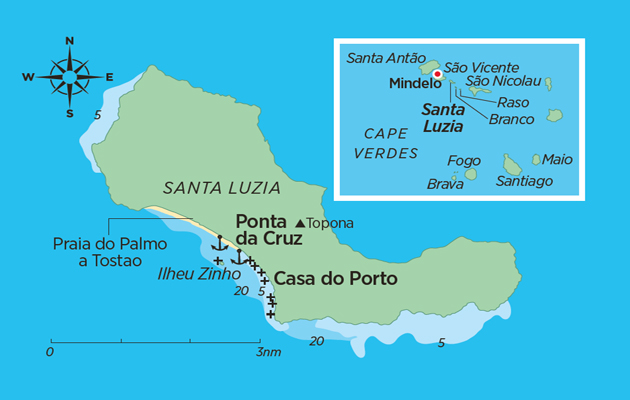It’s hard to find isolated anchorages in the tropics, but Theo Stocker found his own desert island
In the tropics, it won’t be long until your swinging circle of personal space is encroached upon as others crowd into your secret idyll. Remote and isolated anchorages abound in the frozen wastes of the north, but is it possible to have the best of both worlds?
Nowhere is completely perfect, so pragmatism is the best solution: pick the imperfection you mind least, and choose the place where it will drive others away. If you want equatorial heat but don’t mind wind, and lots of it, then alter your course a mile or two off the Atlantic conveyor belt and head for Santa Luzia in the Cape Verde islands.
‘A great arc of white sand swept away without interruption or footprint’
Sitting square in the path of the newly- fledged north-easterly trade wind, Santa Luzia is the smallest island in the archipelago and is completely uninhabited. Scrubland strewn with strange, wind- eroded boulders sweeps up into scree slopes and jagged peaks, which are too low to create clouds, so the island is left arid and barren, in contrast to its taller neighbours. The wind scours ceaselessly around the hills, which provide the only anchorage with little shelter. Here you have the ingredients for absolute isolation, unspoilt by human company.
The sail to Santa Luzia from Tarrafal on São Nicolau is an easy 30-mile beam reach, passing to the north of the nature reserve islands of Raso and Branco. The approach to the island from the south is open and deep. Once you find yourself in the lee of the island, the sea flattens off completely, making for a tenable anchorage despite the wind.
Sail towards the middle of the island, marked by the largest peak, Topona (395m/1,296ft) until you can see Ilheu Zinho, a small islet near the eastern end of the white sand beach, three cables (550m) offshsore. Anchoring is possible anywhere inshore of this islet, with a slowly shelving sandy bottom. In 7m, we laid 50m of chain with an over-sized CQR on the end.
After watching our position for a few hours, we were content that we weren’t going anywhere. Even if we did, it would be out into open water. We kept an anchor watch nevertheless, with one of us staying on the boat. The beach onto which we rowed was a great arc of white sand, sweeping away to the west without interruption or footprint for three miles. In the water, snorkelling offered views of giant boxfish, barracudas and moray eels.
Having scrambled to the summit of Topona, the windward side dropped away vertiginously to a rocky moraine against which Atlantic rollers crashed. Apart from the finches fluttering amongst the stones, and the tiny speck of the boat far below, I was completely alone. We sailed two days later having not seen another soul.
Leaving the island and sailing north- west, it is a fetch against wind and current in order to make it to windward of São Vicente and round into Mindelo, 25 miles away. Going to leeward of the island will leave you with a beat against the wind and current that both accelerate between São Vincente and Santo Antão.





